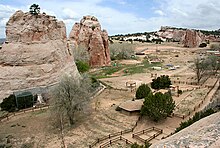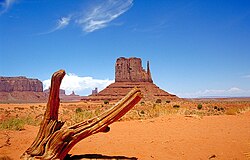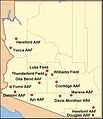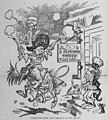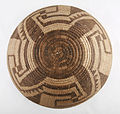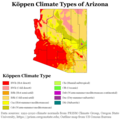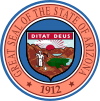Portal maintenance status: (November 2019)
|
| Showcase | Content |
Welcome to the Arizona portal!
Arizona (/ˌærɪˈzoʊnə/ ARR-iz-OH-nə; Navajo: Hoozdo Hahoodzo [hoː˥z̥to˩ha˩hoː˩tso˩]; O'odham: Alĭ ṣonak [ˈaɭi̥ˈʂɔnak]) is a state in the Southwestern region of the United States, sharing the Four Corners region of the western United States with Colorado, New Mexico, and Utah. Its other neighboring states are Nevada to the northwest and California to the west. It also shares an international border with the Mexican states of Sonora and Baja California to the south and southwest. It is the 6th-largest and the 14th-most-populous of the 50 states. Its capital and largest city is Phoenix, which is the most populous state capital in the United States. Arizona is the 48th state and last of the contiguous states to be admitted to the Union, achieving statehood on February 14, 1912. Historically part of the territory of Alta California and Nuevo México in New Spain, it became part of independent Mexico in 1821. After being defeated in the Mexican–American War, Mexico ceded much of this territory to the United States in 1848, where the area became part of the territory of New Mexico. The southernmost portion of the state was acquired in 1853 through the Gadsden Purchase. Southern Arizona is known for its desert climate, with very hot summers and mild winters. Northern Arizona features forests of pine, Douglas fir, and spruce trees; the Colorado Plateau; mountain ranges (such as the San Francisco Mountains); as well as large, deep canyons, with much more moderate summer temperatures and significant winter snowfalls. There are ski resorts in the areas of Flagstaff, Sunrise, and Tucson. In addition to the internationally known Grand Canyon National Park, which is one of the world's seven natural wonders, there are several national forests, national parks, and national monuments. Arizona is home to a diverse population. About one-quarter of the state is made up of Indian reservations that serve as the home of 27 federally recognized Native American tribes, including the Navajo Nation, the largest in the state and the country, with more than 300,000 citizens. Since the 1980s, the proportion of Hispanics has grown significantly owing to migration from Mexico and Central America. A substantial portion of the population are followers of the Roman Catholic Church and the Church of Jesus Christ of Latter-day Saints. Arizona's population and economy have grown dramatically since the 1950s because of inward migration, and the state is now a major hub of the Sun Belt. Cities such as Phoenix and Tucson have developed large, sprawling suburban areas. Many large companies, such as PetSmart and Circle K, have headquarters in the state, and Arizona is home to major universities, including the University of Arizona, Arizona State University, and Northern Arizona University. The state is known for a history of conservative politicians such as Barry Goldwater and John McCain, though it has become a swing state since the 1990s. (Full article...) Selected article - show anotherThe Navajo Nation Zoological and Botanical Park (Navajo: Diné Bikéyah binaaldeehii dóó chʼil danílʼínídi) is located in Window Rock, Arizona, the capital of the Navajo Nation. It is the only tribally owned zoological park in the United States and is notable among zoological facilities in that it labels its exhibits in the Native American Indian language of Navajo. Having been operated by the Navajo Nation Parks & Recreation Department since its inception in the early 1960s, it became part of the Navajo Nation Department of Fish and Wildlife in September 2006. While its facilities have the unique mission of preserving and caring for the fauna and flora significant to Navajo culture, its existence has also sparked controversy among the more traditionalist elements in Navajo society. (Full article...)Did you know (auto-generated) - load new batch
Selected picture - show another
Monument Valley is located on the southern border of Utah with northern Arizona. The valley lies within the range of the Navajo Nation Reservation, and is accessible from U.S. Highway 163. The Navajo name for the valley is Tsé Bii' Ndzisgaii (Valley of the Rocks).The area is part of the Colorado Plateau. The floor is largely Cutler Red siltstone or its sand deposited by the meandering rivers that carved the valley. The valley's vivid red color comes from iron oxide exposed in the weathered siltstone. The darker, blue-gray rocks in the valley get their color from manganese oxide. More did you know - show different entries
WikiProjects
Selected biography - show anotherMajor Burnham in his British Army uniform in 1901 Major Frederick Russell Burnham DSO (May 11, 1861 – September 1, 1947) was an American scout and world-traveling adventurer. He is known for his service to the British South Africa Company and to the British Army in colonial Africa, and for teaching woodcraft to Robert Baden-Powell in Rhodesia. Burnham helped inspire the founding of the international Scouting Movement. Burnham was born on a Dakota Sioux Indian reservation in Minnesota, in the small village of Tivoli near the city of Mankato; there he learned the ways of American Indians as a boy. By the age of 14, he was supporting himself in California, while also learning scouting from some of the last of the cowboys and frontiersmen of the American Southwest. Burnham had little formal education, never finishing high school. After moving to the Arizona Territory in the early 1880s, he was drawn into the Pleasant Valley War, a feud between families of ranchers and sheepherders. He escaped and later worked as a civilian tracker for the United States Army in the Apache Wars. Feeling the need for new adventures, Burnham took his family to southern Africa in 1893, seeing Cecil Rhodes's Cape to Cairo Railway project as the next undeveloped frontier. (Full article...)General images - load new batchThe following are images from various Arizona-related articles on Knowledge (XXG).
News
Wikinews Arizona portal
CategoriesRelated portalsTopicsState facts
State symbols:
Recognized content
Featured articles
Featured lists
Good articles
Featured pictures
Things you can doAssociated WikimediaThe following Wikimedia Foundation sister projects provide more on this subject:
Discover Knowledge (XXG) using portals | |||||||||||||||||||||



